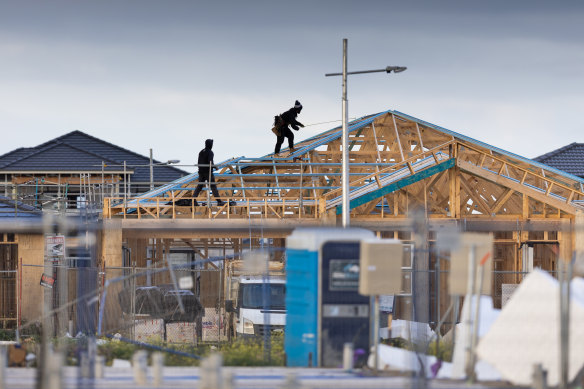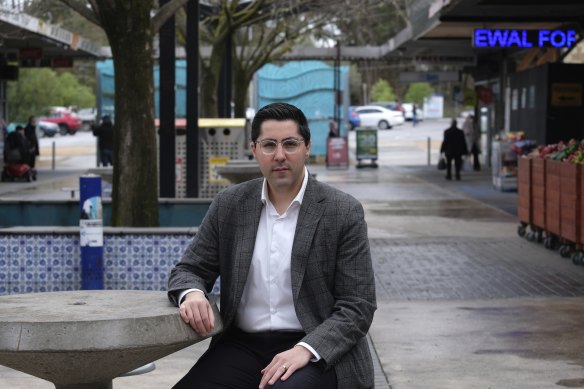Save articles for later
Add articles to your saved list and come back to them any time.
Home owners in Melbourne’s fastest growing suburbs owe tens of millions of dollars in overdue rates as rising inflation pushes more ratepayers into mortgage stress.
The total amount of rates arrears in the city’s outer growth corridors has risen more than 80 per cent in the past three years, analysis of financial statements from Melbourne’s three largest councils reveals.
Councils in Melbourne’s new growth areas are chasing about $100 million in overdue rates.Credit: Jason South
The cities of Hume, Casey and Wyndham collected a combined $766.6 million in rates from property owners last financial year and had $99 million worth of rates in arrears.
The combined rates arrears grew 81 per cent between mid-2020 and mid-2023, from $54.4 million to $98.9 million, and is seen as a sign that home owners in growth suburbs are under worsening financial pressure.
Wyndham experienced an 85.6 per cent increase in rates arrears between 2019-20 and 2022-23, with the amount owed rising from $18.8 million to $34.9 million.
The outer northern City of Hume, which includes the rapidly growing mortgage belt suburbs of Craigieburn, Kalkallo and Mickleham, has had an even larger rise in arrears in that time. It attributed the jump to “new home owners who may not have had previous experience with paying rates”.
“These individuals could find themselves facing financial challenges, particularly in managing a mortgage, especially in light of rising interest rates,” the council said in a recently published report.
The council’s quarterly financial update, published last week, revealed rates arrears had risen from $27.87 million at the end of June to $37.94 million by mid-October.
Weekly household incomes in Hume are below the Victorian and national medians.
City of Hume councillor Joseph Haweil said it was clear that the Reserve Bank’s decision to increase interest rates 12 times in 18 months was pushing people to the edge.
“This is a very worrying trend, reflecting the real pressure that people, particularly working-class people in growth areas, are facing,” Haweil said.
“I think there are a lot of people who have sought the great Australian dream of home ownership in the growth areas, but they have done so at a time when interest rates were historically low, never really anticipating this sort of crushing and blunt tool being used by the Reserve Bank to deal with inflation.”
Last week Reserve Bank governor Michele Bullock flagged further interest rate rises to force down inflation, which is at 4.35 per cent, and said strong demand for haircuts, dentists and dining out were signs that spending continued to overheat the economy.
Haweil said this was not the case in disadvantaged areas such as Hume.
“They’re not throwing money around as if they are millionaires,” he said of residents.
Hume councillor Joseph Haweil said home owners in Melbourne’s north were being crushed by successive interest rate rises.Credit: Luis Ascui
“These are people who are working two jobs, three jobs … to service their mortgages and maintain a standard of living.”
Council “heat maps” reveal that Craigieburn is at the heart of Hume’s growing arrears problem.
Craigieburn Education and Community Centre manager Rita McMillan said the number of people visiting the centre to get food packages had roughly tripled this year but the centre had also had a drop in donations.
“We are a small neighbourhood house relying on donations, but we are struggling there too,” McMillan said. “We find that staff here are actually paying for food out of their own pockets.”
Demand for the education programs the centre offers, such as short courses in digital literacy and English as an additional language, had also dropped, McMillan said.
The courses are free for healthcare cardholders but cost up to $190 for others.
“We are not getting the take-up that we used to, and I would put that down to people … just struggling.”
In Casey, in Melbourne’s south-east, there was a 41.8 per cent increase in rates arrears between August 2020 and now, rising from $18.4 million to $26.1 million.
“We understand that many people may face challenges in paying their rates, and we work hard to support ratepayers by providing flexibility to affected customers where possible,” Casey chair of administrators Noelene Duff said.
The City of Whittlesea’s most recent annual report reveals rates arrears grew 25 per cent in 12 months, from $22.2 million in 2021-22 to $27.8 million in 2022-23.
The City of Melton’s most recent annual report shows a 49.7 per cent increase in rates debtors from $12.41 million to $18.58 million.
“There has been an increase in council rates hardship support to residents as they deal with interest rate increases and other rising cost-of-living pressures,” the council said.
Start the day with a summary of the day’s most important and interesting stories, analysis and insights. Sign up for our Morning Edition newsletter.
Most Viewed in National
From our partners
Source: Read Full Article

